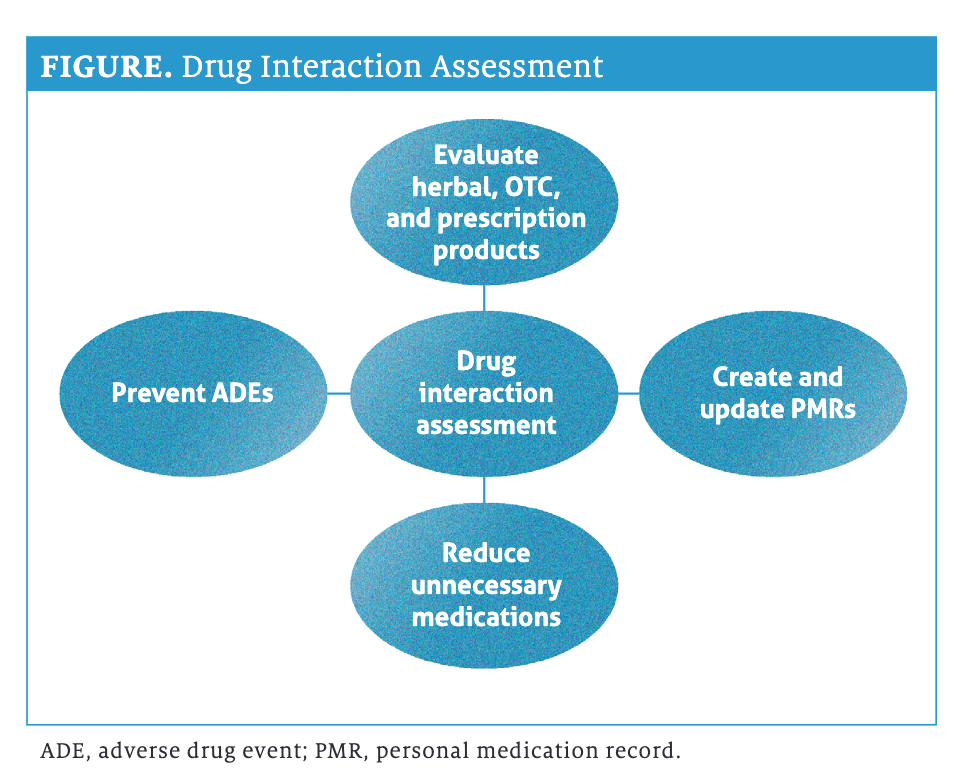Publication
Article
Pharmacy Times
Perform Drug-Drug Interaction Assessments at Every Visit
Author(s):
Pharmacists should evaluate medications for potential problems at patient meetings to improve safety.
Polypharmacy is one of the strongest risk factors for patients experiencing drug interactions, given that approximately 33% of adults in the United States take at least 5 medications.1 Drug interactions can contribute to adverse drug events (ADEs), which account for approximately 700,000 emergency department visits and approximately 100,000 hospitalizations annually.1 An ADE occurs when a patient experiences harm because of medication exposure.1 Unfortunately, approximately 1 of every 6 individuals aged 65 and older will experience a serious ADE from a medication.2 Challenges often occur when patients see multiple prescribers and fill prescriptions at more than 1 pharmacy.2
Approximately 90% of adults aged 50 to 80 years who were surveyed said they were confident about knowing how to avoid drug interactions, according to the University of Michigan National Poll on Healthy Aging.2 However, just 35% of these individuals discussed drug interactions with someone in the past 2 years.2 Additionally, just 36% of study participants reported that their pharmacists knew about all their medications when they filled prescriptions.2
The survey was administered online in April 2017, and the response rate was 77%.2 The findings highlight the importance of assessing for drug interactions to prevent medication-related problems (MRPs; Figure). Pharmacists play a key role in evaluating patients’ pharmacotherapy regimens for drug interactions during medication therapy management (MTM) consults to improve drug safety.

It is critical for pharmacists to assess for drug interactions at each MTM visit and during the dispensing process. They should encourage patients to play an active role in health care by asking questions about their drug therapy. After completing each MTM consult, pharmacists should provide patients with an updated personal medication record (PMR), which should include a list of all herbal supplements and OTC and prescription medications.3 Patients should also update their list and give it to their pharmacists and other health care professionals to assess for drug interactions.3 The PMR should include medication names, drug dosages, indications, frequency and schedule, start and stop dates, prescribing provider, and additional instructions.3
In a retrospective study, pharmacists identified MRPs, along with recommendations to resolve them.4 There were 36,455 MRPs identified in the study, and 9716 (26.7%) were classified as drug interactions. The study results showed that pharmacists play a critical role in identifying MRPs. Medications most frequently involved in drug interactions included amlodipine, atorvastatin, citalopram, clopidogrel, hydrocodone-acetaminophen, metoprolol, simvastatin, tamsulosin, tramadol, trazodone, and warfarin.
One study evaluated medication lists from the electronic health records of 6545 patients in ambulatory care aged 60 and older to identify multidrug interactions (MDIs).5 The highest prevalence of MDIs was on medication lists containing amiodarone, bupropion, cyclobenzaprine, methotrexate, tramadol, and trazodone.5 Psychotropic medications (35%) were most involved in drug interactions, followed by cardiovascular drugs (11%).5 Other medication classes involved in MDIs included anticoagulants (9%), opioids (9%), immunosuppressants (8%), nonsteroidal anti inflammatory drugs (4%), and muscle relaxants (3%).5 The most common serious potential ADEs associated with the drug interactions were bleeding, prolonged QT interval, seizures, and serotonin syndrome.
References
- Medication errors and adverse drug events. Agency for Healthcare Research and Quality. September 7, 2019. Accessed September 12, 2022. https://psnet.ahrq.gov/primer/medication-errors-and-adverse-drug-events
- Drug interactions: how to avoid them. Institute for Healthcare Policy and Innovation National Poll on Healthy Aging. November 29, 2017. Accessed September 12, 2022. https://www.healthyagingpoll.org/reports-more/report/drug-interactions-how-avoid-them
- Chapter 1: medication therapy management. National Board of Medication Therapy Management. Accessed September 12, 2022. https://www.nbmtm.org/mtm-reference/medication-therapy-management/
- Bankes D, Pizzolato K, Finnel S, et al. Medication-related problems identified by pharmacists in an enhanced medication therapy management model. Am J Manag Care. 2021;27(suppl 16):S292-S299. doi:10.37765/ajmc.2021.88754
- Anand TV, Wallace BK, Chase HS. Prevalence of potentially harmful multidrug interactions on medication lists of elderly ambulatory patients. BMC Geriatrics. 2021;21(1):648. doi:10.1186/s12877-021-02594-z
About the Author
Jennifer Gershman, PharmD, CpH, PACS, is a drug information pharmacist and Pharmacy Times® contributor who lives in South Florida.






